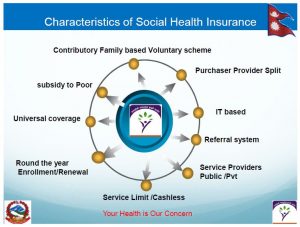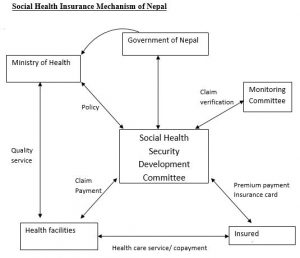
Introduction:
- First of all, before moving into Social Health Insurance, let us get refreshed with what Insurance mean? Insurance is a means by which risk and uncertain events are shared among many people providing protection from financial losses.
- Likewise health insurance is defined as a “type of insurance coverage that pays for medical and surgical expenses incurred by the insured” (Investopedia, 2017).
- Health insurance is one of the key requirement/means to achieve Universal Health Coverage which includes coverage dimensions of: healthcare coverage (adequate health care) and population coverage (health care for all)
- Now, moving on to Social health insurance (SHI), it is a type of insurance program set up by government to raise and pool funds in order to provide finance for health services along with government subsidies for poor people. SHI is also one of the principle method of health care financing.
- It protects people from financial burden and improves access to quality health services.
- As per the principle of SHI, SHI involves compulsory membership among all the population where they (enrolled population) are supposed to pay specific premium in exchange of benefit.
- Government legislation describes the premium and benefits to be provided and can be changed through political process.
- All those with ability to pay will make contribution into social health insurance fund where workers and enterprises make contribution through their salary while self-employed persons contribution is decided either in flat rate of based on estimated income.
- On the other hand, government may contribute on behalf of those who would not be able to pay. Eg: unemployed people, low income informal workers etc
- SHI includes two main concepts:
- Health and wellness can be achieved through sharing and utilization of resources using strategies which are mutually beneficial.
- Health is a fundamental human right. Under social health insurance program, members have equal access to health services and also receive equal benefits from them.
Advantages of SHI:
- Risk pooling.
- Resources are shared.
- Reduction in out of pocket expenditure.
- Potential of providing high risk protection, especially in high income countries
- Equitable access to quality health service.
- Development of health system- improved information system, proper planning and utilization of health services.
- It adds to health revenue source.
- Greater public participation.
Limitations of SHI:
- It may exclude poor and marginalized groups unless subsidy is provided by government
- Requires adequate financial capacity of the government to incorporate all the population
- It does not provide all type of health promotion and disease prevention services.
- Over and unnecessary utilization of health services- moral hazards.
- Administrative cost may be high.
Health Provider network of SHI:
For providing health services for those enrolled in SHI scheme, SHI either:
- Has its own provider network where it works with qualified and recognized public and private health care providers OR
- Uses a combination of both private and public providers working independently
Similarly, it must not be forgotten that, different functions like registration, collection of premiums, reimbursement of providers etc. can also be implemented by parastatal or non-governmental institutions.
Factors affecting the coverage of Social Health Insurance:
- Level of income of an individual
- Rate of economic growth of the nation
- Structure of economy i.e. formal economy or informal economy (Note: informal economy creates administrative difficulties)
- Country’s ability to administer
- Level of solidarity in a society where individuals are willing and determined to help the needy ones
Social Health Insurance in Nepal:
- Health insurance program was developed and received approval from cabinet of Nepal in April, 2014.
- Central coordinating board has formed and its office has been established in three districts (IIlam, Baglung, Kailali) in 2014.
- Social Health Security Development Committee has been formed in the central level under the chair of Secretary of Health to look after the program holistically
- Cabinet of Nepal approved National social health insurance act in January 2015.
- Currently, program is being carried out in different phases. In the first phase, it was implemented in three districts while in second phase, in five districts and in the third phase; program will be implemented in Tanahun and four other districts.

Major features of Social Health Security Program (Health insurance) of Nepal
- Universal coverage: People of all ages are eligible.
- Family size: five members. Additional members can be added.
- Premium payment is annual. Annual renewal.
- Registration: door to door visit by enrollment assistance.
- Co-payment: yes for medicine but not for free medicine
- Payment for service by patient: Rs 140 for OPD and emergency service and Rs 80 for Primary centers.
- Referrals: Available in central, regional and zonal hospitals.
- Premium : NPR 2500 for five members of family per year : NPR 425 for each additional member of family per year
- Subsidy by government for poor : 100% for ultra poor, 75% for poor, 50% for vulnerable group and 50% discount for FCHV
Benefits:
- Payment for health services: NPR 50,000/ 5 members/ year , NPR 10,000/ member/ year (Maximum NPR 1,00,000)
- Health care services : OPD visits, Emergency services, Operations, Preventive, Promotive, Curative and rehabilitative services, Laboratory investigation, radiology, Free drugs. Also, all free services will remain free.
Note: Insurance plan will not cover for: Cosmetic surgery, Abortion, Equipment like artificial organ, reading glass of not more than Rs 500 in a year, hearing machine, Organ transformation service, sex transformation etc, Accident related treatment due to alcohol and drug use and Dental treatment (tooth implant, root canalling).

Challenges for the program
- Increasing insurance coverage (At present, coverage is only 5%).
- Enrolling people into insurance plan.
- Determining poor and making poverty card and its implementation.
- Achieving 100% health insurance by 2030.
- Continuity of service.
- Providing quality services.
- Increasing access to health care services.
Opportunities for the program
- Political support; Health insurance act 2074.
- Greater government commitment.
- Strengthening of health system.
- Support to poor people; access to quality health services.
References and for further reading:
http://www.who.int/healthsystems/topics/financing/healthreport/26_10Q.pdf
http://apps.searo.who.int/PDS_DOCS/B3457.pdf
http://www.who.int/health_financing/documents/shi_key_factors.pdf
http://nhsp.org.np/wp-content/uploads/2017/02/14.Social-Health-Security-Program.pdf
http://nhssp.org.np/jar/2015/Social_health_insurance.pdf
http://www.investopedia.com/terms/h/healthinsurance.asp
https://www.slideshare.net/WHO-EMRO/social-health-insurance-for-universal-health-coverage
http://dohs.gov.np/wp-content/uploads/2017/09/Health-Insurance.pdf
http://www.kumj.com.np/issue/18/268-272.pdf
https://thehimalayantimes.com/nepal/government-set-launch-health-insurance/
https://stats.oecd.org/glossary/detail.asp?ID=2487
https://www.giz.de/en/worldwide/17887.html
http://www.sciencedirect.com/science/article/pii/S0167629616301886
http://kathmandupost.ekantipur.com/news/2016-09-16/877-people-buy-health-insurance.html
Author of this article: Ms. Rojina Tandukar. Ms. Tandukar is pursuing her Bachelor’s degree in Public Health from a reputed University.